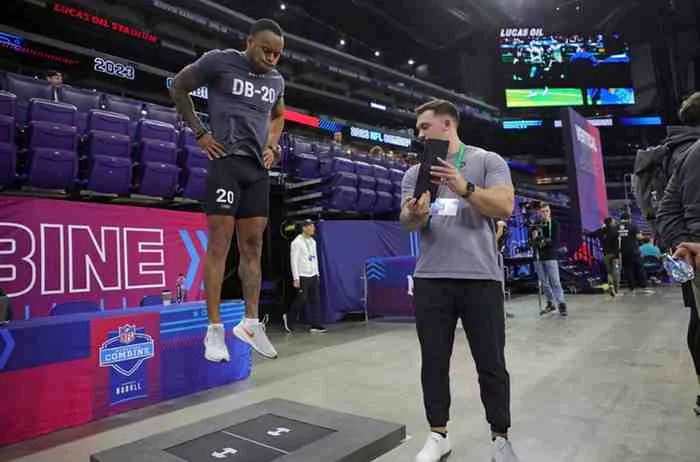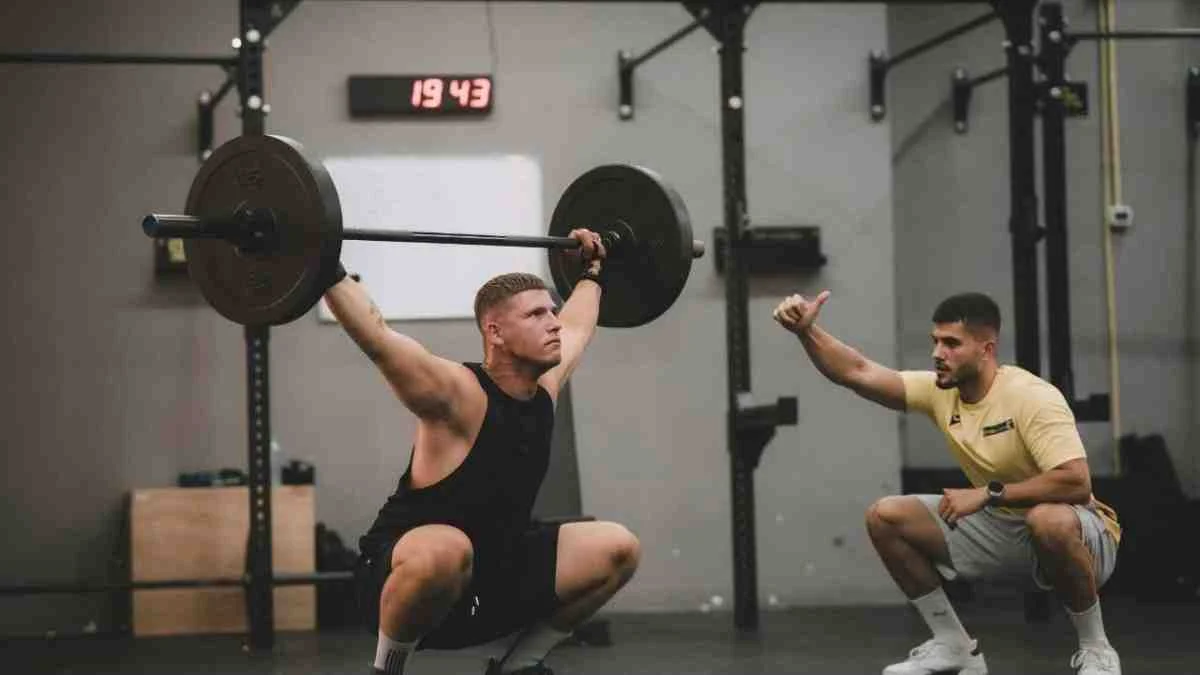In 2024, both the NBA Combine and the CFL Combine switched from the Vertec to The Top Hopper Vertical Jump System for their vertical jump tests. Many other combines have also made the same switch. At the NBA Combine, athletes are routed to two vertical jump stations:
Station #1: Max Vertical Jump – Here, the NBA Combine uses a Top Hopper TH500 Floor Stand System with an extension tube to measure the running max vertical jump. The standard configuration can measure a jump height up to 147.5 inches. Adding the extension tube safely raises the measuring device another two feet off the ground.
Station #2: Sargent Jump – This station measures a stationary Sargent Jump. They use a Top Hopper TH500 Floor Stand System in combination with Hawkin force plates. They use the TH500 to accurately measure the vertical jump height and use the force plates for jump performance data.
Feedback from the strength and conditioning coaches that ran the stations was very positive—they said the stations went very fast this year and everyone loved it!
A vertical jump measuring device must be accurate, repeatable, and reproducible, says Scott Mervis. Share on XI entered the world of measuring vertical jump heights about eight years ago—I have a Bachelor’s Degree in Mechanical Engineering and was a basketball coach for many years. After buying several vert testers and talking with thousands of trainers and strength and conditioning coaches, I have a very good understanding of the marketplace. Please allow me to share what I have learned.
The 3 Qualities Experts Demand From a Vertical Jump Measuring Device
It must be:
- ACCURATE – If an athlete can jump 42 inches, then the equipment must measure 42 inches. The measurement tolerance must be +/- a half inch. For example, the equipment should measure 41.5 – 42.5 inches.
- REPEATABLE – The equipment must deliver the same measurements every time when using the same operator, athlete, process, and procedure. If you cannot repeat the measurements, then you cannot calculate the accuracy of your equipment and will never have reproducibility.
- REPRODUCIBLE – The equipment must be reproducible. If the same equipment and procedure is used, an athlete’s vertical jump height should measure the same height regardless of location and operator. For example, if a trainer replicates the same procedure used at the NBA Combine and uses the same equipment, then the athlete should have the same vertical jump height measurement at both locations.
Trainers and strength and conditioning coaches basically have two requirements:
- It must be accurate. “Why would I use a vert tester to measure vertical jump heights if the measurements are not accurate.”
- It must be easy to use. “My time is limited, so it can’t take long to get the measurement.”
Market Segmentation
What vertical jump measuring equipment does everyone use? That is a great question. These numbers are not exact, but close enough for our purposes.
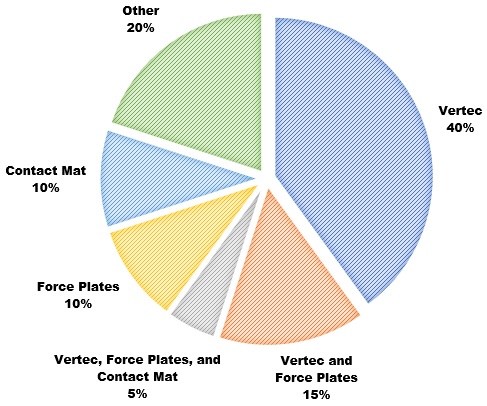
Vertical jump testers are either:
- Mechanical – These are moved up and down manually and have plastic indicators the athlete hits to identify the measurement location. The operator has to manually calculate the vertical jump height.
- Electronic – These provide a digital measurement that has a complex calculation built into the equipment processor.
All types of equipment have pros and cons. Every trainer and strength and conditioning coach has a reason for why they use a certain piece of equipment. The NBA Combine is no different.
After six years of designing, testing, and improving, The Top Hopper vertical jump measuring system was launched. All of the complaints that coaches had about the Vertec were targeted and eliminated, says Scott Mervis. Share on XPros & Cons of Force Plates, Contact Mats, and Mechanical Jump Testers
Let’s first start with the oldest products. In the late 1970’s, force plates entered the market. Force plates are designed to provide data on the athlete’s strength, movement, asymmetries, and balance. To say it another way, force plates measure the ground reaction forces applied during the jump.
If you are looking for an accurate vertical jump measurement, force plates are not the right piece of equipment. If you are looking to collect data on jump performance, then you have to get force plates. Share on XThe ground reaction forces and flight time are used to calculate vertical jump height. Unfortunately, the calculated height is always several inches below the actual height measured against a mechanical tester. So, if you are looking for an accurate vertical jump measurement, force plates are not the right piece of equipment. If you are looking to collect data on jump performance, then you have to get force plates.
-
Pros:
- Best piece of equipment for analyzing jump performance.
- Eliminates human “math” errors when measuring.
- Delivers repeatable and reproducible measurements.
- Delivers an inaccurate vertical jump height (~3 inches lower).
- Can only measure a stationary Sargent jump.
- Vertical jump height is a calculation.
- Very easy to cheat the vertical jump height calculation.
- Most expensive—requires an annual software subscription.
- Heavy and not easily portable.
- Highest level of technical knowledge required to use.
Cons:
Contact mats were introduced in the early 1990s. They use pressure-sensitive sensors to detect when an athlete leaves and then lands back on the mat. The system includes a timing mechanism to record the duration of the jump. The flight time analysis is used to calculate the jump height.
-
Pros:
- Easily portable.
- Eliminates human “math” errors when measuring.
- A low-cost electronic vert tester.
- Without a VERY controlled procedure, they deliver the least accurate vertical jump height—jump heights can very drastically depending on athlete’s body position.
- Can only measure a stationary Sargent jump.
- Vertical jump height is a calculation.
- Very easy to cheat the vertical jump height calculation.
- Durability issues.
Cons:
The Vertec was introduced in the early 1990s. It was the most popular mechanical tester and was the Gold Standard until 2023. The NBA Combine used a Vertec through 2023. The Vertec has no electronic component. It has plastic indicators above the athlete that are used for measuring the vertical jump height, which is manually calculated. The measuring device is raised and lowered into position by the operator.
-
Pros:
- Prior to 2023, the Vertec was the most accurate vertical jump measuring device on the market.
- Delivers good repeatability and reproducible measurements.
- Can be used to measure all types of jumps (Sargent, one-step, or running max jump).
- Baseline for all other vert testers to be compared against.
- Very difficult to cheat—only by not reaching up as high as possible during the standing reach baseline measurement.
- It has been proven that athletes jump higher when a visual target is provided.
- Cost competitive.
- Durability issues.
- Math is difficult.
- Telescopic design results in accuracy issues—the pole bends the higher it is raised.
- Some models require counterweight to be added to prevent them from falling over.
- All adjustments were made at chest height, exposing the measuring device to damage when not in use.
- Versatility and portability.
- Can only measure up to 144 inches from the ground.
Cons:
Why Mechanical Testers Are the #1 Choice for Measuring Vertical Jump Height
It’s pretty simple to understand why mechanical testers are the most popular. If you want to accurately measure vertical jump heights, then you must use a mechanical tester. Mechanical vert testers have no limitation on what types of jumps you can measure, and studies show that athletes jump higher when they have visual targets.
Also, mechanical testers are very hard to “cheat.” The only way for an athlete to cheat the tester is to not reach as high as they can when capturing the standing reach height. This is why almost all sports combines use mechanical testers. They are very simple pieces of equipment that everyone uses correctly, which allows for repeatable and reproducible measurements.
Mechanical vert testers have no limitation on what types of jumps you can measure, and studies show that athletes jump higher when they have visual targets, says Scott Mervis. Share on XElectronic measuring devices are very accurate when the procedure and the athlete’s jump is highly controlled. Unfortunately, in the real world, athletes can easily cheat the calculation by doing several things during the jump process to delay landing on the mat or force plates. Mechanical testers are also limited to measuring only a stationary jump.
Everything You Need to Know About the Vertec
Manufactured and sold by Sports Imports, Vertec has been the “standard” vertical jump tester for over 30 years. It is the benchmark that every other vert tester is compared against.
There are two Vertec systems available:
- A floor stand system.
- A wall mounted system.
The most common is the floor stand system. It measures in half-inch increments across a range of 72 inches to 144 inches from the ground. The measuring device is attached to square tubing that telescopes. This telescopic tube has etched markings on it that are measurements from the ground. The operator will tighten a screw at the etched line to hold it in place. The athlete will jump and hit thin plastic vanes, which identify the peak of the jump. The base of the floor stand is painted red. The inside telescopic square tube is bare steel.
Manufactured and sold by Sports Imports, Vertec has been the 'standard' vertical jump tester for over 30 years. It is the benchmark that every other vert tester is compared against. Share on XHere are some of the complaints I heard from thousands of trainers and strength and conditioning coaches.
- Determining the height of an athlete’s vertical jump is a difficult process.
- The math is confusing.
- It breaks easily.
- It takes up a lot of space.
- It is time consuming for a large group.
- It leans the higher it is raised.
- It only comes in red.
Birth of The Top Hopper
In 2016, I decided to make the best vertical jump measuring device—after six years of designing, testing, and making improvements, The Top Hopper vertical jump measuring system was launched. All of the complaints that coaches had about the Vertec were targeted and eliminated.
Today, The Top Hopper vertical jump measuring systems are industrial grade and the most accurate vert tester on the market. The process for measuring an athlete’s jump height is quick and easy. There are four powder-coated steel mounting systems that do not telescope:
- Traditional floor stand
- Wall mount
- Basketball rim mount
- Extender mount
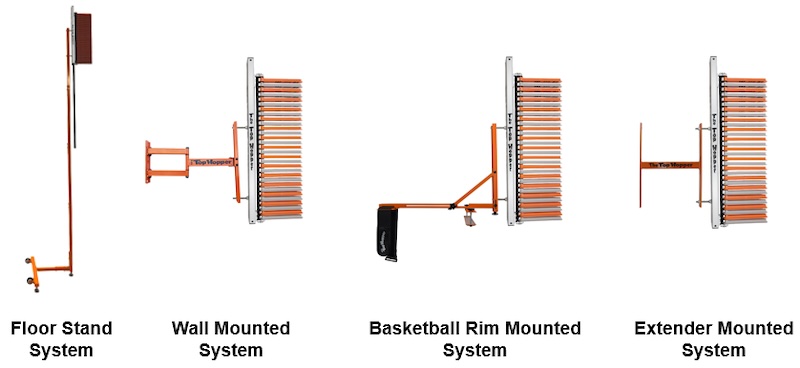
All four are stocked in four colors with the option for custom colors. There is a TH500 measuring device that measures in ½” increments and a TH1000 that measures in 1” increments. Both are stocked in six color combinations along with an option for custom colors.
Comparing the Top Two Mechanical Vertical Jump Measuring Systems
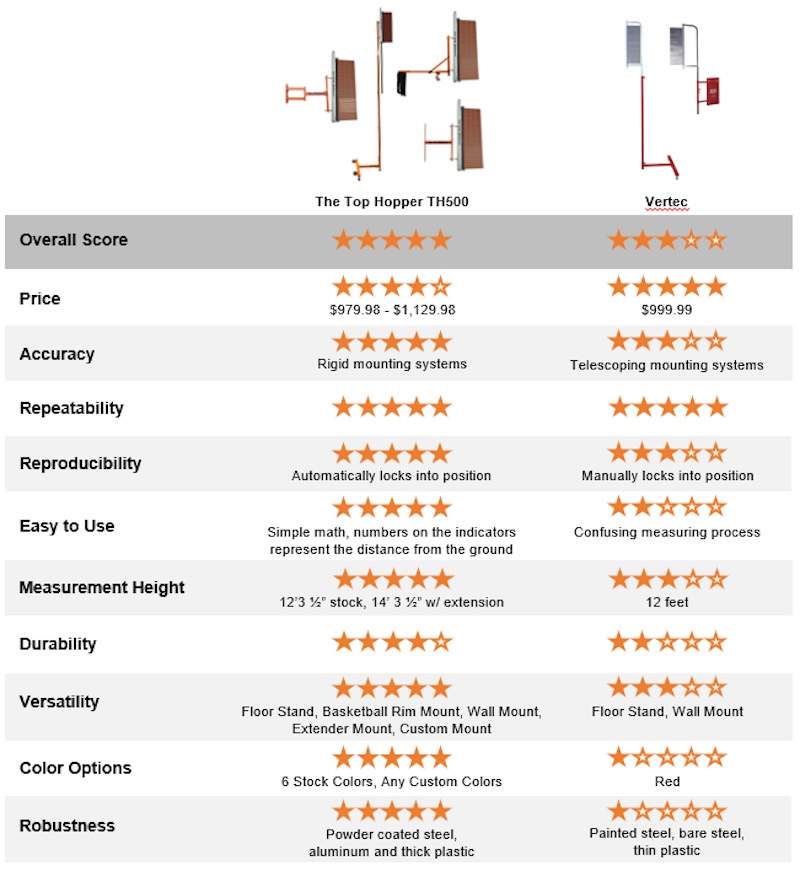
As more trainers and coaches become aware of The Top Hopper, its popularity continues to grow. The most common comment I get? “Where have you been the past 30 years?”
Since you’re here…
…we have a small favor to ask. More people are reading SimpliFaster than ever, and each week we bring you compelling content from coaches, sport scientists, and physiotherapists who are devoted to building better athletes. Please take a moment to share the articles on social media, engage the authors with questions and comments below, and link to articles when appropriate if you have a blog or participate on forums of related topics. — SF





